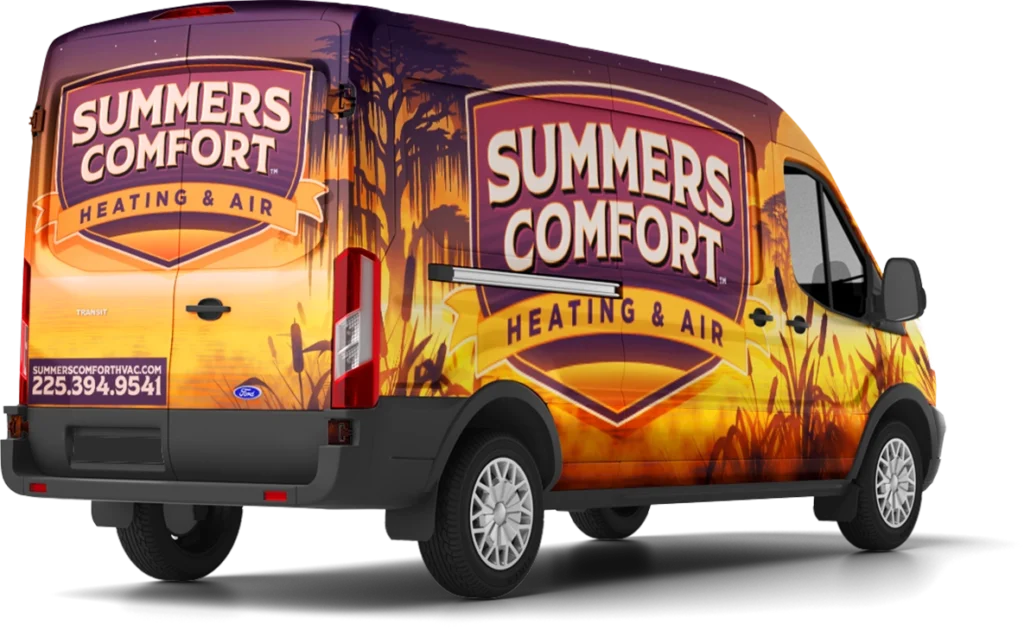If you’re considering a new HVAC setup or trying to understand your current system, you’ve probably come across the term forced air. It’s one of the most common types of heating and cooling systems in the U.S., but many homeowners don’t fully understand how it works—or whether it’s the best choice for their home.
At Summers Comfort Heating & Air, we’ve worked on every type of HVAC system out there. We often get questions about forced air, so we put together this guide to explain what it is, how it compares to other options, and what you should know before upgrading or replacing your setup.
What Is a Forced Air System?
A forced air system uses ducts and vents to push heated or cooled air throughout your home. It usually includes a central unit (like a furnace or heat pump), a blower motor, and ductwork.
Unlike radiant heating or mini-splits, forced air systems rely on air circulation. The unit heats or cools the air, then the blower distributes it to each room through a network of ducts.
You’ll usually find forced air systems powered by gas, electricity, or even oil. Some setups also include air filtration or humidifiers, giving you better indoor air quality along with comfort.
How Forced Air Heating and Cooling Works
The process is fairly straightforward. First, your thermostat senses the temperature and signals the system to turn on. The heat exchanger or evaporator coil kicks in to heat or cool the air. Then, the blower fan pushes that air through the ductwork and out the vents into your living spaces.
Because it’s a centralized system, forced air tends to respond quickly. That makes it efficient for heating or cooling large areas evenly. However, airflow can be inconsistent if the ducts are poorly designed or not maintained.
Pros of Forced Air Systems
Fast and Even Heating or Cooling
Forced air delivers temperature changes quickly. You’ll usually feel the difference within a few minutes of adjusting your thermostat.
Air Filtration and Ventilation
Many forced air systems include air filters, which help remove dust, pollen, and allergens from the air. Some setups even allow for add-ons like UV lights or humidifiers.
Cost-Effective Installation (If Ducts Exist)
If your home already has ductwork, installing or upgrading a forced air system is often more affordable than switching to ductless alternatives.
Dual Heating and Cooling Options
You can use the same ductwork for both heating and air conditioning, which simplifies the system and reduces long-term maintenance.
Cons of Forced Air Systems
Duct Issues Can Reduce Efficiency
Leaks, blockages, or poor insulation in the ductwork can waste energy. According to ENERGY STAR, up to 30% of air can be lost due to leaky ducts.
Uneven Airflow in Older Homes
In older or multi-story homes, it’s not uncommon for some rooms to feel warmer or cooler than others. This often points to a design issue or a lack of zoning.
Noise from the Blower or Ducts
If the system hasn’t been tuned or insulated well, you might hear whistling vents or the blower kicking on and off. While this isn’t always a problem, it can be annoying.
Maintenance Requirements
Filters need to be replaced regularly, and ducts should be inspected every few years. A clogged filter or blocked vent can make your system work harder, raising energy bills and shortening equipment life.
It’s also important to:
Schedule seasonal tune-ups to check components like the blower motor and heat exchanger.
Keep registers and vents clear of furniture or curtains to maintain airflow.
Listen for unusual noises, which may indicate duct leaks or motor issues.
These simple steps help keep your forced air system running efficiently and extend its lifespan. ENERGY STAR also recommends seasonal maintenance to help your HVAC system run at peak efficiency.
How Forced Air Compares to Other Systems
Forced Air vs. Radiant Heat
Radiant systems use heated surfaces—like floors or panels—to warm a space. While they’re quieter and don’t rely on air movement, they usually cost more to install and don’t provide cooling.
Forced Air vs. Mini-Split Systems
Ductless mini-splits are ideal for smaller spaces or homes without existing ductwork. They’re efficient but can be less effective at regulating even temperatures across larger areas.
If you’re debating between the two, read our guide on mini-split sizing and setup.
Is a Forced Air System Right for You?
If your home already has ducts—or if you’re building a new home with multiple rooms—a forced air system can be an efficient and flexible choice. It allows for both heating and cooling, offers good air circulation, and supports add-ons like whole-house humidifiers or advanced filtration systems.
That said, it’s important to consider duct condition, system sizing, and any hot/cold spots in your home before making the call. A professional assessment can help ensure you’re getting the performance you expect.
Let Summers Comfort Help You Make the Right Choice
While forced air systems remain one of the most popular HVAC options, they’re not one-size-fits-all. If you’re not sure which type of system makes sense for your home, we’re here to help.
At Summers Comfort Heating & Air, we’ve been serving homeowners with honest recommendations, efficient installs, and thorough system evaluations for years. Whether you’re upgrading, replacing, or troubleshooting your current system, our team can help you decide which option is best for your home.
If you’re in Gastonia, Baton Rouge, or one of the surrounding areas, give us a call or schedule service online. We’ll help you find a solution that keeps your home comfortable year-round.

